Chenyu Wang
Michael
Slm-mux: Orchestrating small language models for reasoning
Oct 06, 2025Abstract:With the rapid development of language models, the number of small language models (SLMs) has grown significantly. Although they do not achieve state-of-the-art accuracy, they are more efficient and often excel at specific tasks. This raises a natural question: can multiple SLMs be orchestrated into a system where each contributes effectively, achieving higher accuracy than any individual model? Existing orchestration methods have primarily targeted frontier models (e.g., GPT-4) and perform suboptimally when applied to SLMs. To address this gap, we propose a three-stage approach for orchestrating SLMs. First, we introduce SLM-MUX, a multi-model architecture that effectively coordinates multiple SLMs. Building on this, we develop two optimization strategies: (i) a model selection search that identifies the most complementary SLMs from a given pool, and (ii) test-time scaling tailored to SLM-MUX. Our approach delivers strong results: Compared to existing orchestration methods, our approach achieves up to 13.4% improvement on MATH, 8.8% on GPQA, and 7.0% on GSM8K. With just two SLMS, SLM-MUX outperforms Qwen 2.5 72B on GPQA and GSM8K, and matches its performance on MATH. We further provide theoretical analyses to substantiate the advantages of our method. In summary, we demonstrate that SLMs can be effectively orchestrated into more accurate and efficient systems through the proposed approach.
Seeing from Another Perspective: Evaluating Multi-View Understanding in MLLMs
Apr 21, 2025Abstract:Multi-view understanding, the ability to reconcile visual information across diverse viewpoints for effective navigation, manipulation, and 3D scene comprehension, is a fundamental challenge in Multi-Modal Large Language Models (MLLMs) to be used as embodied agents. While recent MLLMs have shown impressive advances in high-level reasoning and planning, they frequently fall short when confronted with multi-view geometric consistency and cross-view correspondence. To comprehensively evaluate the challenges of MLLMs in multi-view scene reasoning, we propose All-Angles Bench, a benchmark of over 2,100 human carefully annotated multi-view question-answer pairs across 90 diverse real-world scenes. Our six tasks (counting, attribute identification, relative distance, relative direction, object manipulation, and camera pose estimation) specifically test model's geometric correspondence and the capacity to align information consistently across views. Our extensive experiments, benchmark on 27 representative MLLMs including Gemini-2.0-Flash, Claude-3.7-Sonnet, and GPT-4o against human evaluators reveals a substantial performance gap, indicating that current MLLMs remain far from human-level proficiency. Through in-depth analysis, we show that MLLMs are particularly underperforming under two aspects: (1) cross-view correspondence for partially occluded views and (2) establishing the coarse camera poses. These findings highlight the necessity of domain-specific refinements or modules that embed stronger multi-view awareness. We believe that our All-Angles Bench offers valuable insights and contribute to bridging the gap between MLLMs and human-level multi-view understanding. The project and benchmark are publicly available at https://danielchyeh.github.io/All-Angles-Bench/.
Reward-Guided Controlled Generation for Inference-Time Alignment in Diffusion Models: Tutorial and Review
Jan 16, 2025



Abstract:This tutorial provides an in-depth guide on inference-time guidance and alignment methods for optimizing downstream reward functions in diffusion models. While diffusion models are renowned for their generative modeling capabilities, practical applications in fields such as biology often require sample generation that maximizes specific metrics (e.g., stability, affinity in proteins, closeness to target structures). In these scenarios, diffusion models can be adapted not only to generate realistic samples but also to explicitly maximize desired measures at inference time without fine-tuning. This tutorial explores the foundational aspects of such inference-time algorithms. We review these methods from a unified perspective, demonstrating that current techniques -- such as Sequential Monte Carlo (SMC)-based guidance, value-based sampling, and classifier guidance -- aim to approximate soft optimal denoising processes (a.k.a. policies in RL) that combine pre-trained denoising processes with value functions serving as look-ahead functions that predict from intermediate states to terminal rewards. Within this framework, we present several novel algorithms not yet covered in the literature. Furthermore, we discuss (1) fine-tuning methods combined with inference-time techniques, (2) inference-time algorithms based on search algorithms such as Monte Carlo tree search, which have received limited attention in current research, and (3) connections between inference-time algorithms in language models and diffusion models. The code of this tutorial on protein design is available at https://github.com/masa-ue/AlignInversePro
Automated Generation of Challenging Multiple-Choice Questions for Vision Language Model Evaluation
Jan 06, 2025



Abstract:The rapid development of vision language models (VLMs) demands rigorous and reliable evaluation. However, current visual question answering (VQA) benchmarks often depend on open-ended questions, making accurate evaluation difficult due to the variability in natural language responses. To address this, we introduce AutoConverter, an agentic framework that automatically converts these open-ended questions into multiple-choice format, enabling objective evaluation while reducing the costly question creation process. Our experiments demonstrate that AutoConverter can generate correct and challenging multiple-choice questions, with VLMs demonstrating consistently similar or lower accuracy on these questions compared to human-created ones. Using AutoConverter, we construct VMCBench, a benchmark created by transforming 20 existing VQA datasets into a unified multiple-choice format, totaling 9,018 questions. We comprehensively evaluate 33 state-of-the-art VLMs on VMCBench, setting a new standard for scalable, consistent, and reproducible VLM evaluation.
Semantic Consistency-Based Uncertainty Quantification for Factuality in Radiology Report Generation
Dec 05, 2024Abstract:Radiology report generation (RRG) has shown great potential in assisting radiologists by automating the labor-intensive task of report writing. While recent advancements have improved the quality and coherence of generated reports, ensuring their factual correctness remains a critical challenge. Although generative medical Vision Large Language Models (VLLMs) have been proposed to address this issue, these models are prone to hallucinations and can produce inaccurate diagnostic information. To address these concerns, we introduce a novel Semantic Consistency-Based Uncertainty Quantification framework that provides both report-level and sentence-level uncertainties. Unlike existing approaches, our method does not require modifications to the underlying model or access to its inner state, such as output token logits, thus serving as a plug-and-play module that can be seamlessly integrated with state-of-the-art models. Extensive experiments demonstrate the efficacy of our method in detecting hallucinations and enhancing the factual accuracy of automatically generated radiology reports. By abstaining from high-uncertainty reports, our approach improves factuality scores by $10$%, achieved by rejecting $20$% of reports using the Radialog model on the MIMIC-CXR dataset. Furthermore, sentence-level uncertainty flags the lowest-precision sentence in each report with an $82.9$% success rate.
CAD-MLLM: Unifying Multimodality-Conditioned CAD Generation With MLLM
Nov 07, 2024

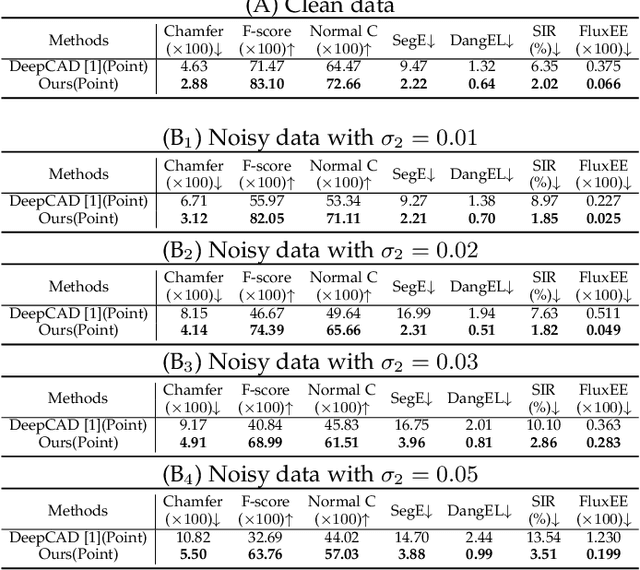
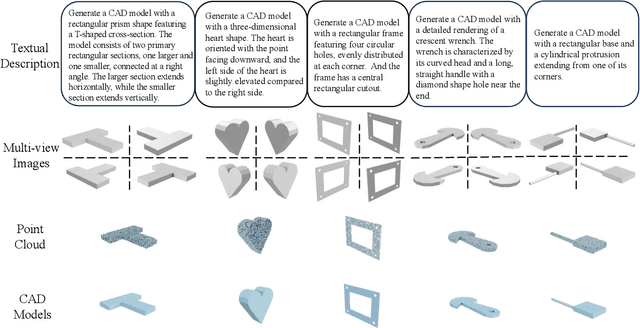
Abstract:This paper aims to design a unified Computer-Aided Design (CAD) generation system that can easily generate CAD models based on the user's inputs in the form of textual description, images, point clouds, or even a combination of them. Towards this goal, we introduce the CAD-MLLM, the first system capable of generating parametric CAD models conditioned on the multimodal input. Specifically, within the CAD-MLLM framework, we leverage the command sequences of CAD models and then employ advanced large language models (LLMs) to align the feature space across these diverse multi-modalities data and CAD models' vectorized representations. To facilitate the model training, we design a comprehensive data construction and annotation pipeline that equips each CAD model with corresponding multimodal data. Our resulting dataset, named Omni-CAD, is the first multimodal CAD dataset that contains textual description, multi-view images, points, and command sequence for each CAD model. It contains approximately 450K instances and their CAD construction sequences. To thoroughly evaluate the quality of our generated CAD models, we go beyond current evaluation metrics that focus on reconstruction quality by introducing additional metrics that assess topology quality and surface enclosure extent. Extensive experimental results demonstrate that CAD-MLLM significantly outperforms existing conditional generative methods and remains highly robust to noises and missing points. The project page and more visualizations can be found at: https://cad-mllm.github.io/
An Information Criterion for Controlled Disentanglement of Multimodal Data
Oct 31, 2024Abstract:Multimodal representation learning seeks to relate and decompose information inherent in multiple modalities. By disentangling modality-specific information from information that is shared across modalities, we can improve interpretability and robustness and enable downstream tasks such as the generation of counterfactual outcomes. Separating the two types of information is challenging since they are often deeply entangled in many real-world applications. We propose Disentangled Self-Supervised Learning (DisentangledSSL), a novel self-supervised approach for learning disentangled representations. We present a comprehensive analysis of the optimality of each disentangled representation, particularly focusing on the scenario not covered in prior work where the so-called Minimum Necessary Information (MNI) point is not attainable. We demonstrate that DisentangledSSL successfully learns shared and modality-specific features on multiple synthetic and real-world datasets and consistently outperforms baselines on various downstream tasks, including prediction tasks for vision-language data, as well as molecule-phenotype retrieval tasks for biological data.
Fine-Tuning Discrete Diffusion Models via Reward Optimization with Applications to DNA and Protein Design
Oct 17, 2024Abstract:Recent studies have demonstrated the strong empirical performance of diffusion models on discrete sequences across domains from natural language to biological sequence generation. For example, in the protein inverse folding task, conditional diffusion models have achieved impressive results in generating natural-like sequences that fold back into the original structure. However, practical design tasks often require not only modeling a conditional distribution but also optimizing specific task objectives. For instance, we may prefer protein sequences with high stability. To address this, we consider the scenario where we have pre-trained discrete diffusion models that can generate natural-like sequences, as well as reward models that map sequences to task objectives. We then formulate the reward maximization problem within discrete diffusion models, analogous to reinforcement learning (RL), while minimizing the KL divergence against pretrained diffusion models to preserve naturalness. To solve this RL problem, we propose a novel algorithm, DRAKES, that enables direct backpropagation of rewards through entire trajectories generated by diffusion models, by making the originally non-differentiable trajectories differentiable using the Gumbel-Softmax trick. Our theoretical analysis indicates that our approach can generate sequences that are both natural-like and yield high rewards. While similar tasks have been recently explored in diffusion models for continuous domains, our work addresses unique algorithmic and theoretical challenges specific to discrete diffusion models, which arise from their foundation in continuous-time Markov chains rather than Brownian motion. Finally, we demonstrate the effectiveness of DRAKES in generating DNA and protein sequences that optimize enhancer activity and protein stability, respectively, important tasks for gene therapies and protein-based therapeutics.
"What" x "When" working memory representations using Laplace Neural Manifolds
Sep 30, 2024

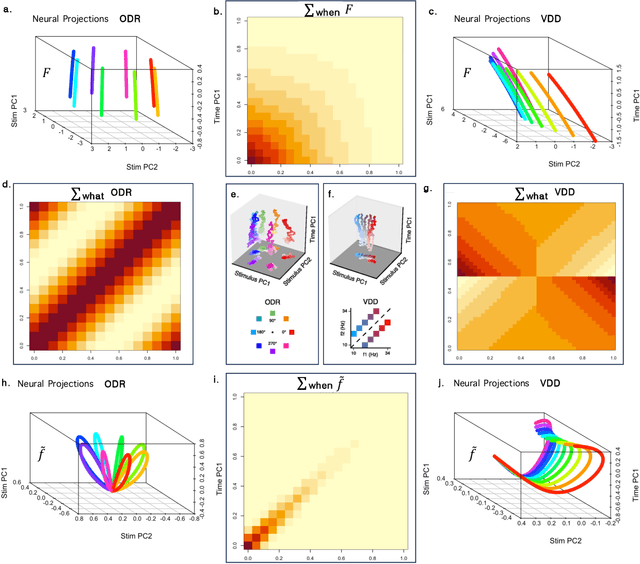

Abstract:Working memory $\unicode{x2013}$ the ability to remember recent events as they recede continuously into the past $\unicode{x2013}$ requires the ability to represent any stimulus at any time delay. This property requires neurons coding working memory to show mixed selectivity, with conjunctive receptive fields (RFs) for stimuli and time, forming a representation of 'what' $\times$ 'when'. We study the properties of such a working memory in simple experiments where a single stimulus must be remembered for a short time. The requirement of conjunctive receptive fields allows the covariance matrix of the network to decouple neatly, allowing an understanding of the low-dimensional dynamics of the population. Different choices of temporal basis functions lead to qualitatively different dynamics. We study a specific choice $\unicode{x2013}$ a Laplace space with exponential basis functions for time coupled to an "Inverse Laplace" space with circumscribed basis functions in time. We refer to this choice with basis functions that evenly tile log time as a Laplace Neural Manifold. Despite the fact that they are related to one another by a linear projection, the Laplace population shows a stable stimulus-specific subspace whereas the Inverse Laplace population shows rotational dynamics. The growth of the rank of the covariance matrix with time depends on the density of the temporal basis set; logarithmic tiling shows good agreement with data. We sketch a continuous attractor CANN that constructs a Laplace Neural Manifold. The attractor in the Laplace space appears as an edge; the attractor for the inverse space appears as a bump. This work provides a map for going from more abstract cognitive models of WM to circuit-level implementation using continuous attractor neural networks, and places constraints on the types of neural dynamics that support working memory.
Unsupervised dMRI Artifact Detection via Angular Resolution Enhancement and Cycle Consistency Learning
Sep 24, 2024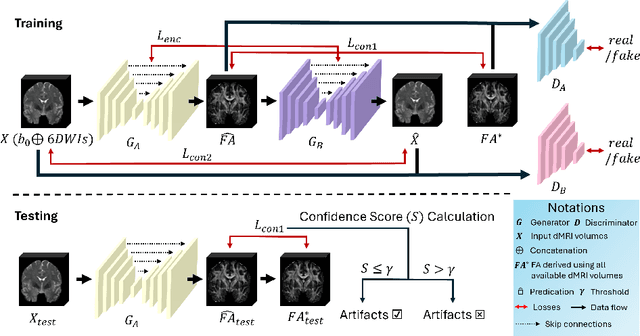
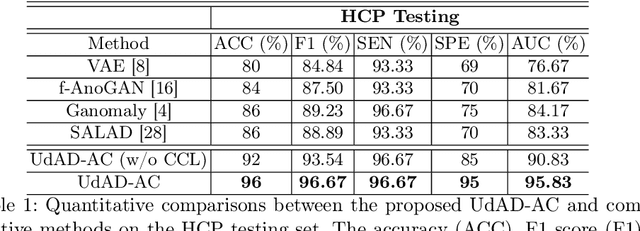


Abstract:Diffusion magnetic resonance imaging (dMRI) is a crucial technique in neuroimaging studies, allowing for the non-invasive probing of the underlying structures of brain tissues. Clinical dMRI data is susceptible to various artifacts during acquisition, which can lead to unreliable subsequent analyses. Therefore, dMRI preprocessing is essential for improving image quality, and manual inspection is often required to ensure that the preprocessed data is sufficiently corrected. However, manual inspection requires expertise and is time-consuming, especially with large-scale dMRI datasets. Given these challenges, an automated dMRI artifact detection tool is necessary to increase the productivity and reliability of dMRI data analysis. To this end, we propose a novel unsupervised deep learning framework called $\textbf{U}$nsupervised $\textbf{d}$MRI $\textbf{A}$rtifact $\textbf{D}$etection via $\textbf{A}$ngular Resolution Enhancement and $\textbf{C}$ycle Consistency Learning (UdAD-AC). UdAD-AC leverages dMRI angular resolution enhancement and cycle consistency learning to capture the effective representation of artifact-free dMRI data during training, and it identifies data containing artifacts using designed confidence score during inference. To assess the capability of UdAD-AC, several commonly reported dMRI artifacts, including bias field, susceptibility distortion, and corrupted volume, were added to the testing data. Experimental results demonstrate that UdAD-AC achieves the best performance compared to competitive methods in unsupervised dMRI artifact detection.
 Add to Chrome
Add to Chrome Add to Firefox
Add to Firefox Add to Edge
Add to Edge